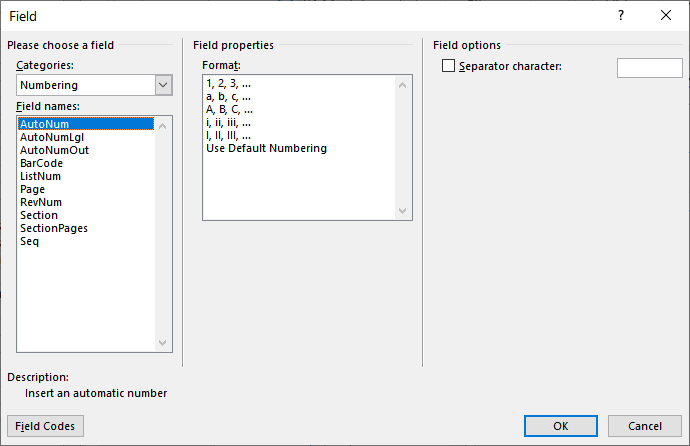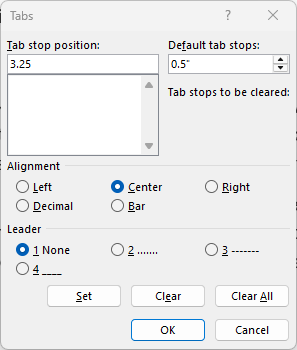Written by Allen Wyatt (last updated October 4, 2025)
This tip applies to Word 2007, 2010, 2013, 2016, 2019, 2021, 2024, and Word in Microsoft 365
One WordTips reader expressed a desire to number the various equations appearing in his document. The desire was to have the equation centered on the page, and the equation's number appear at the right margin within brackets. When a new equation is added to the document, the subsequent equations should be renumbered.
There are several ways you can approach this problem, but the possible solutions can be broken down into two general methods. The first method accomplishes the numbering using a combination of tables and fields, and the second uses tabs and fields. If you want to use the table approach, you can do so as follows:

Figure 1. The Field dialog box.
If you want to use tabs to accomplish the same task, you can easily do that, as well. For instance, let's say you are using 8.5 x 11 paper, with 1-inch left and right margins. In this case, you would follow these steps:

Figure 2. The Tabs dialog box.
The advantage of using the tab method (as just described) is that you can define a paragraph style that already has the two tab stops set. You can then format any paragraph with the style and simply type your information. You can take it one step further and also save the brackets and sequence field as a Building Block entry. In this way you could very quickly enter your sequence numbers.
When you add new equations in the middle of your document, it is very possible that not all of your subsequent equations will automatically increment. If you want to make sure that all the sequence numbers are correct, you can select the entire document and press F9 to update the fields.
WordTips is your source for cost-effective Microsoft Word training. (Microsoft Word is the most popular word processing software in the world.) This tip (273) applies to Microsoft Word 2007, 2010, 2013, 2016, 2019, 2021, 2024, and Word in Microsoft 365.

Do More in Less Time! An easy-to-understand guide to the more advanced features available in the Microsoft 365 version of Word. Enhance the quality of your documents and boost productivity in any field with this in-depth resource. Complete your Word-related tasks more efficiently as you unlock lesser-known tools and learn to quickly access the features you need. Check out Microsoft 365 Word For Professionals For Dummies today!
Frames are an object you can place in your document. They go back to the earliest days of Word, before text boxes were ...
Discover MoreSome people, while developing documents, like to use the Highlighter tool quite a bit. It can quickly get monotonous, ...
Discover MoreIf you establish dynamic links between documents, then you can force Word to update those links whenever you want. How ...
Discover MoreFREE SERVICE: Get tips like this every week in WordTips, a free productivity newsletter. Enter your address and click "Subscribe."
There are currently no comments for this tip. (Be the first to leave your comment—just use the simple form above!)
Got a version of Word that uses the ribbon interface (Word 2007 or later)? This site is for you! If you use an earlier version of Word, visit our WordTips site focusing on the menu interface.
Visit the WordTips channel on YouTube
FREE SERVICE: Get tips like this every week in WordTips, a free productivity newsletter. Enter your address and click "Subscribe."
Copyright © 2025 Sharon Parq Associates, Inc.
Comments